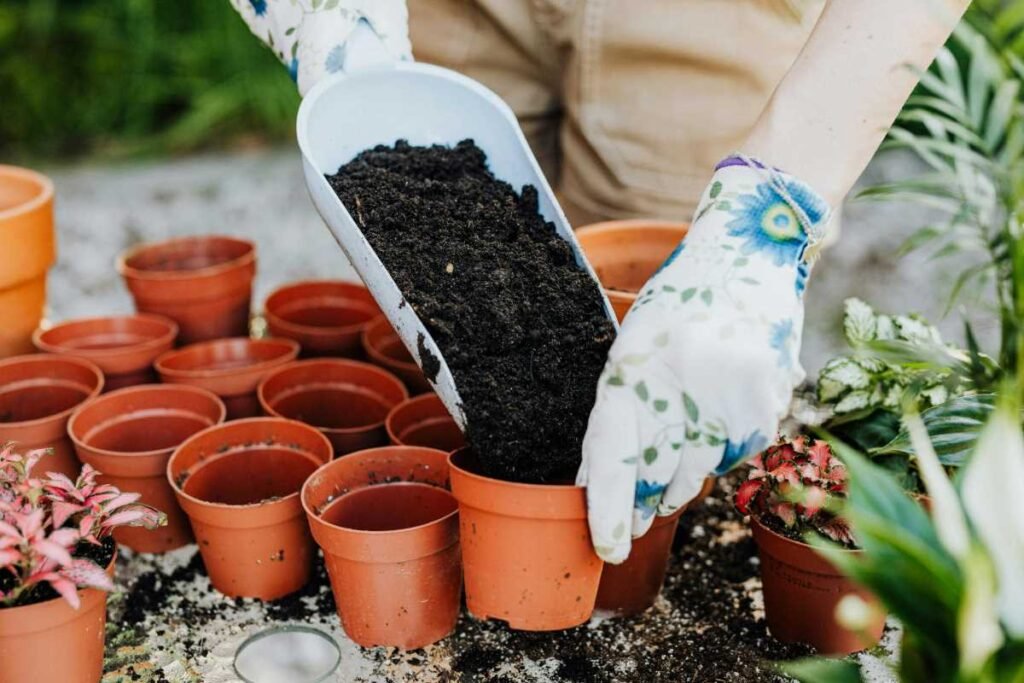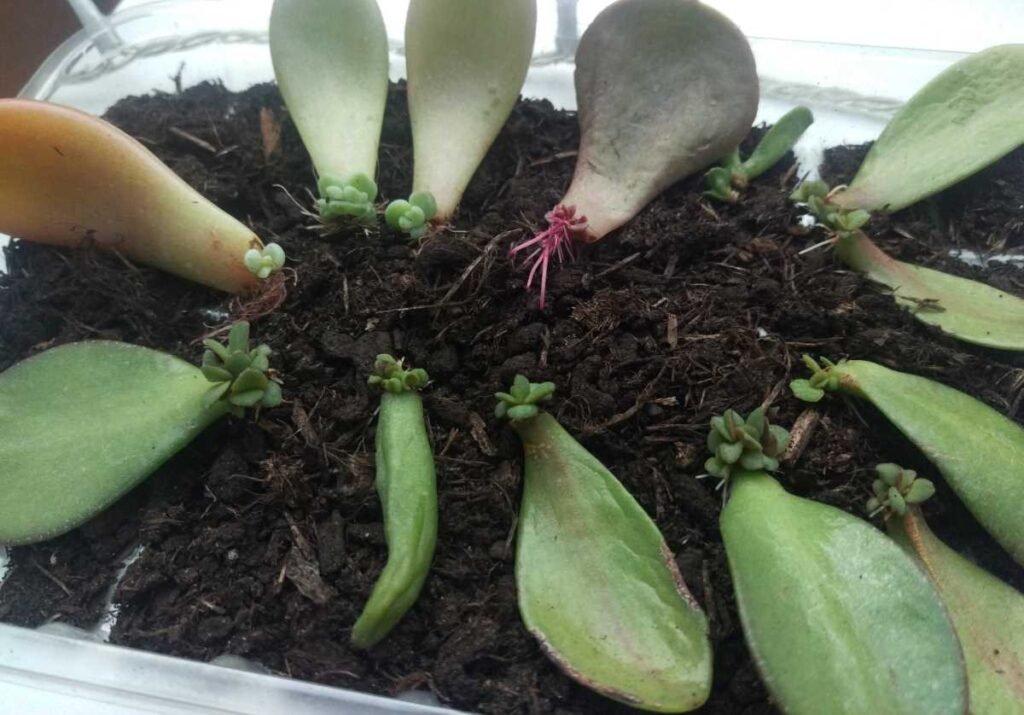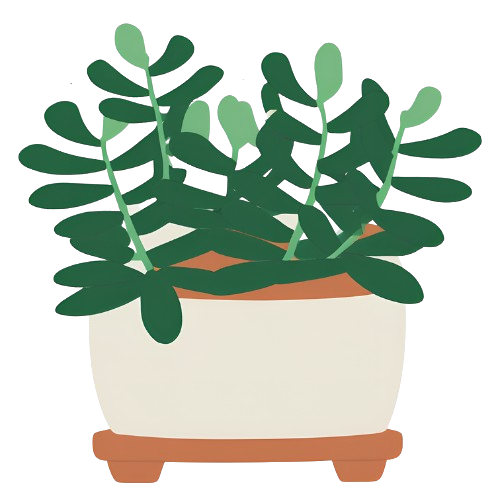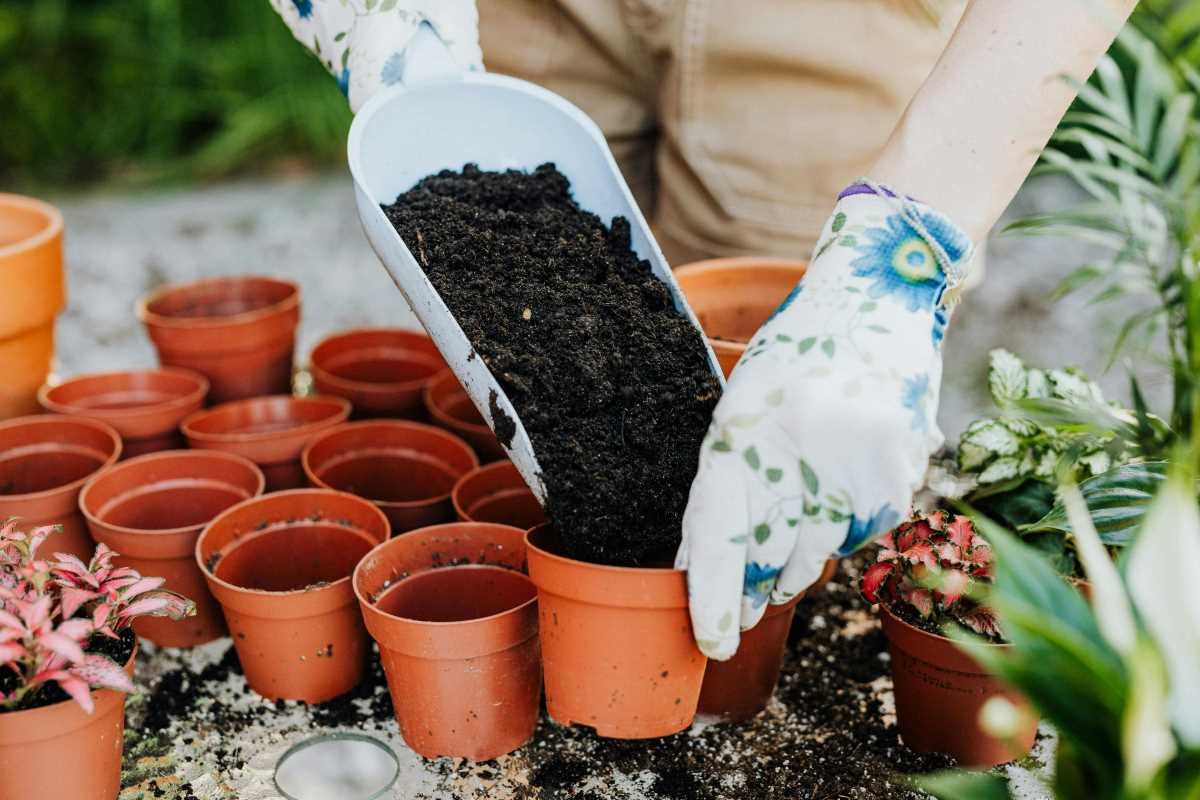Have you ever wondered why your jade plant isn’t thriving? The secret might be right under your nose – or more precisely, under your plant.
The soil you use makes all the difference for jade plants. These popular succulents have special needs that regular potting soil just can’t meet.
In this guide, I’ll share everything you need to know about soil for jade plants. We’ll explore what makes good jade plant soil, how to mix your own, and how to keep your plant happy in its earthy home.
Let’s dig in and help your jade plant flourish!

Table of Contents
Why Soil Matters for Jade Plants
Jade plants come from dry parts of South Africa. In nature, they grow in rocky, sandy soil. This soil drains very fast. After rain, the water flows away quickly. The roots don’t sit in wet soil.
Our homes are different from the wild places where jade plants grow. We keep these plants in pots. Pots can trap water. This is why the right soil is so key for jade plant health.
Good soil helps your jade plant in many ways:
- It lets excess water drain away from the roots
- It gives roots air to breathe
- It holds just enough water for the plant to drink
- It provides some nutrients for growth
- It anchors the plant so it stands up tall
Bad soil does the opposite. It stays wet too long. It suffocates roots. It may not feed the plant well. And wet soil leads to the worst problem of all: root rot.
Root rot kills more jade plants than any other issue. Once it starts, it’s hard to stop. The roots turn black and mushy. The stems get soft. The plant can die very fast.
So how do we prevent this sad end? We start with the right soil mix.
What Makes Good Jade Plant Soil?

Good jade plant soil has four main qualities. It is fast-draining, has good air flow, offers some nutrients, and has the right pH level. Let’s look at each of these.
Fast-Draining
This is the most vital soil trait for jade plants. The soil must let water flow through quickly. When you water your jade plant, the water should run out the pot’s drain holes within seconds.
Why? Jade plants store water in their leaves. They don’t need to soak up water from soil for long periods. Their roots prefer to dry out between watering.
Slow-draining soil stays wet for days. This can rot the roots and kill the plant. Fast-draining soil helps prevent this deadly problem.
Good Air Flow
Plant roots need to breathe. Yes, just like us, they need air! Roots take in oxygen and release carbon dioxide. Good soil has spaces for air to move around the roots.
Dense, packed soil blocks air flow. The roots can’t breathe well. This weakens the plant over time.
Jade plant soil should feel loose when you touch it. It should have small spaces for air to move through. This keeps roots healthy and happy.
Some Nutrients
Jade plants don’t need lots of food. They grow slowly and use nutrients at a slow pace. But they do need some basic nutrition from their soil.
Good jade plant soil provides:
- Nitrogen for leaf growth
- Phosphorus for root development
- Potassium for overall health
- Small amounts of other minerals
The soil doesn’t need to be super rich. In fact, too many nutrients can harm jade plants. They prefer a lean diet over a rich one.
The Right pH Level
Soil pH measures how acidic or alkaline (basic) the soil is. Jade plants like soil that is neutral to slightly acidic. This means a pH between 6.0 and 7.0.
At this pH level, jade plants can take up nutrients well. If the soil is too acidic or too alkaline, the plant may not be able to use the nutrients in the soil.
Most commercial cactus soils have pH in this range. If you mix your own soil, you can test the pH with a simple soil test kit from a garden store.
What Not to Use for Jade Plant Soil
Before we talk about good soil options, let’s be clear about what NOT to use:
Regular Potting Soil
Regular potting soil is made for plants that like more water. It has peat moss and other materials that hold moisture. This is too wet for jade plants. It can lead to root rot.
Signs your jade plant has soil that’s too moisture-retentive include:
- Soil that stays wet for days after watering
- Yellow, mushy leaves
- Black, soft stems
- A musty smell from the pot
- Mold growing on the soil surface
If you see these signs, it’s time to repot your jade plant in better soil.
Pure Garden Soil
Garden soil from your yard seems natural. After all, plants grow in it outside. But garden soil gets hard in pots. It packs down with watering. This blocks air and water movement.
Garden soil may also have:
- Insect eggs
- Weed seeds
- Harmful fungi
- Clay that holds too much water
For these reasons, never use plain garden soil for jade plants.
Pure Sand
Some people think desert plants need sandy soil. While sand drains well, pure sand doesn’t give plants nutrients. It can also pack down over time.
Sand can be part of a good jade plant soil mix. But using only sand will lead to a sad, hungry plant.
Commercial Soil Options for Jade Plants
Now let’s talk about soils you can buy. Garden stores sell several types of soil that work for jade plants.
Cactus and Succulent Soil
This is the easiest option. Soil made for cacti and succulents has the fast drainage jade plants need. Brands like Miracle-Gro, Espoma, and Black Gold make good versions.
Cactus soil usually contains:
- Regular potting soil
- Perlite or pumice
- Sand
- Sometimes small gravel
This mix drains well but still holds some moisture and nutrients. It’s a good starting point for jade plants.
But here’s a tip: even commercial cactus soil can sometimes hold too much water for jade plants. You can improve it by mixing in extra perlite or pumice. Add about one part perlite to four parts cactus soil.
Bonsai Soil
Bonsai soil works well for jade plants too. It’s made for trees grown in pots. Like jade plants, bonsai trees need good drainage.
Bonsai soil contains:
- Akadama (clay granules)
- Pumice
- Lava rock
- Sometimes pine bark
This soil drains very well. It also helps strong root growth. The only downside is that bonsai soil can be more costly than other options.
Orchid Mix
In a pinch, orchid mix can work for jade plants. Orchid mix is made of:
- Bark pieces
- Charcoal
- Sometimes perlite or sponge rock
This mix drains very fast and has great air flow. But it may not hold enough water for jade plants. If you use orchid mix, you may need to water more often.
DIY Jade Plant Soil Recipes
Making your own soil gives you total control. You can adjust the mix to suit your watering habits and local climate. Here are three DIY soil recipes for jade plants.
Basic Jade Plant Soil Mix
This simple mix works in most homes:
What you need:
- 3 parts commercial cactus soil
- 1 part perlite or pumice
- 1 part coarse sand
How to mix:
- Pour the cactus soil into a bucket or large pot
- Add the perlite or pumice
- Add the sand
- Mix well with a trowel or your hands
- Store any extra soil in a dry place
This mix drains well but still holds some water. It’s good for people who tend to water plants on a regular schedule.
Fast-Draining Jade Plant Mix
If you tend to overwater or live in a humid place, try this mix:
What you need:
- 2 parts commercial cactus soil
- 2 parts perlite or pumice
- 1 part coarse sand
- 1 part small gravel or chicken grit
How to mix:
- Combine all items in a large container
- Mix until evenly blended
- Use for jade plants that need extra drainage
This mix dries out quickly. It’s good for places with high humidity or for people who love to water their plants often.
Water-Retentive Jade Plant Mix
If you live in a dry climate or often forget to water, this mix holds a bit more moisture:
What you need:
- 4 parts commercial cactus soil
- 1 part perlite or pumice
- 1 part coarse sand
- 1 part coco coir (pre-soaked and drained)
How to mix:
- Soak the coco coir in water, then squeeze out excess
- Mix all items together in a large container
- Use for jade plants in dry areas or for forgetful waterers
The coco coir holds some water but doesn’t stay soggy. This gives your plant a little extra drinking time between waterings.
Key Soil Ingredients Explained

Let’s take a closer look at the items used in jade plant soil. Knowing these will help you make smart choices when buying or mixing soil.
Perlite
Perlite is the white, lightweight stuff that looks like tiny styrofoam balls. It’s actually volcanic glass that has been heated until it pops like popcorn.
Perlite creates air pockets in soil. It doesn’t soak up much water itself. Water runs around the perlite pieces, helping drainage.
Perlite is:
- Very lightweight
- pH neutral
- Sterile (free of pests and disease)
- Long-lasting in soil
You can buy perlite at most garden stores. It comes in different grades from fine to coarse. For jade plants, medium or coarse perlite works best.
Pumice
Pumice is another volcanic rock. It looks like light-colored gravel with tiny holes all through it.
Pumice works like perlite. It creates drainage and air space. But pumice has some benefits over perlite:
- It’s heavier, so it helps anchor plants
- It doesn’t float to the top of pots when watered
- It provides some minerals to the soil
The downside is that pumice can be harder to find and may cost more than perlite.
Coarse Sand
Sand helps with drainage too. But not all sand is good for plants. You need coarse horticultural sand or construction sand.
Good sand for jade plants has:
- Large, gritty particles
- No salt (never use beach sand!)
- No fine dust
The gritty texture allows water to flow through quickly. It also adds weight to help hold plants upright.
Small Gravel
Small gravel or chicken grit adds drainage and weight. The small stones create paths for water to flow through.
For jade plants, use:
- 1/8 to 1/4 inch size stones
- Washed gravel (free of dirt)
- Natural stone (not dyed)
You can find small gravel at garden stores, pet stores (sold as “aquarium gravel”), or feed stores (sold as “chicken grit”).
Coco Coir
Coco coir comes from coconut husks. It’s a more eco-friendly option than peat moss. Coir holds some water but also contains air pockets.
For jade plants, coir should be:
- Just a small part of the mix
- Pre-soaked and drained before mixing
- Broken up so there are no clumps
Don’t use too much coir. It can hold more water than jade plants like. But a small amount helps the soil keep some moisture.
How to Tell if Your Soil Mix is Right
Not sure if your jade plant soil is good? Here’s how to test it:
The Water Test
- Put your soil mix in a pot with drainage holes
- Water it well, until water runs out the bottom
- Time how long it takes for water to drain through
- Check the soil one hour after watering
Good jade plant soil should:
- Let water drain through in seconds, not minutes
- Feel damp but not soggy one hour after watering
- Be almost dry to the touch within 24 hours
If water sits on top or drains very slowly, the soil is too dense. Add more perlite or pumice.
The Finger Test
Once your jade plant is potted, the finger test helps check soil moisture:
- Stick your finger about an inch into the soil
- If it feels dry at that depth, it’s time to water
- If it still feels damp, wait a few more days
Good jade plant soil lets you use this test easily. Your finger should slide into the soil without much force. And you should feel a clear difference between wet and dry soil.
The Weight Test
Another way to check is by lifting the pot:
- Lift the pot right after watering to feel its weight
- Lift it again a few days later
- The pot should feel much lighter when the soil is dry
If the pot stays heavy for many days, the soil is holding too much water.
Special Soil Needs for Different Jade Plants
Not all jade plants are the same. Different types may need slightly different soil.
Standard Jade Plant (Crassula ovata)
The common jade plant does well with any of the mixes we’ve talked about. It’s sturdy and adapts to different soil types, as long as they drain well.
Variegated Jade Plants
Jade plants with white or cream stripes grow more slowly. They may need a bit more nutrition in their soil. Add a small amount of worm castings to your mix for these plants.
Dwarf Jade Plants
Smaller jade varieties like ‘Minima’ or ‘Hobbit’ need less water than larger types. Use a fast-draining mix for these small plants. They’re more prone to rot if kept too wet.
Baby Jade Plants and Cuttings
Young jade plants and fresh cuttings need special care. Their roots are small and delicate. For these plants:
- Use a mix with more perlite for extra drainage
- Add a thin layer of fine sand on top to keep the stem dry
- Wait longer between waterings until the plant is well-rooted
This helps baby plants grow strong roots without rotting.
Seasonal Soil Considerations
Your jade plant’s soil needs change with the seasons. Here’s how to adjust through the year:
Spring and Summer
In the growing seasons:
- The soil can hold a bit more moisture
- Plants use more water as they grow
- The soil dries faster in warm weather
During spring and summer, a standard mix works well. The plant will use the water as it grows new leaves and stems.
Fall and Winter
In the dormant seasons:
- Plants need much less water
- Soil stays wet longer in cool weather
- The risk of root rot increases
During fall and winter, a faster-draining mix is better. Or simply water much less often. The soil should dry out completely between waterings.
If you live where winters are dark and cold, consider adding more perlite to your mix in fall. This gives extra protection against wet soil in winter.
Repotting and Refreshing Jade Plant Soil
Even the best soil doesn’t last forever. Over time, it breaks down. It may drain more slowly. The nutrients wash away. This is why repotting is important.
When to Repot Jade Plants
Most jade plants need repotting every 2-3 years. Signs it’s time to repot include:
- Roots growing out of drainage holes
- Water sitting on top of soil instead of draining
- The plant becoming top-heavy and tipping over
- Slowed growth (even in spring and summer)
- Soil that never seems to dry out
Spring is the best time to repot. The plant is starting active growth then.
How to Repot Jade Plants
Repotting gives you a chance to refresh the soil. Here’s how to do it:
- Prepare fresh soil mix ahead of time
- Choose a new pot just one size larger than the current one
- Make sure the new pot has drainage holes
- Water the plant a day or two before repotting
- Gently remove the plant from its old pot
- Brush away as much old soil as you can without damaging roots
- Check roots for rot (they should be firm and light-colored)
- Cut away any black or mushy roots with clean scissors
- Put fresh soil in the bottom of the new pot
- Place the plant in the pot, adding soil around the sides
- Leave the soil level about 1/2 inch below the pot rim
- Don’t water right away – wait about a week
This gives your jade plant fresh soil with good drainage. The waiting period after repotting lets any damaged roots heal before they get wet.
Soil Top-Dressing
If your plant isn’t ready for full repotting, you can refresh just the top layer of soil:
- Carefully scrape off the top inch of old soil
- Don’t disturb the main roots
- Add fresh soil mix on top
- Water lightly after top-dressing
This gives some fresh soil without the stress of full repotting. It’s good for older jade plants that don’t like being disturbed.
Fertilizing Jade Plant Soil
Soil provides some nutrients. But over time, plants use these up. This is where fertilizer helps.
Fertilizer Types for Jade Plants
Jade plants don’t need strong fertilizer. Good options include:
Succulent fertilizer – Made just for plants like jade. It has the right balance of nutrients.
Balanced liquid fertilizer – Use at 1/4 to 1/2 the strength listed on the package.
Worm castings – A gentle, natural option. Mix a small amount into the top layer of soil.
Time-release succulent fertilizer – Adds nutrients slowly over months.
Fertilizing Schedule
Jade plants need fertilizer only during active growth. A good schedule is:
- Spring and summer: Fertilize lightly every 4-6 weeks
- Fall and winter: Don’t fertilize at all
Always apply fertilizer to damp soil, never dry. This prevents root burn.
Signs of Fertilizer Problems
Too much fertilizer can harm jade plants. Watch for these warning signs:
- White crust on the soil surface
- Leaf burn (brown tips or edges)
- Very fast, weak growth
- Leaves falling off easily
If you see these signs, flush the soil with clean water. Then hold off on fertilizer for several months.
Troubleshooting Jade Plant Soil Problems
Even with the right soil, problems can happen. Here’s how to spot and fix common soil issues.
Soil Staying Too Wet
If your soil doesn’t dry out between waterings:
- Add more perlite or pumice (up to 50% of the mix)
- Make sure the pot has drainage holes
- Consider a clay pot, which lets moisture escape through the sides
- Check that the plant gets enough light to use the water
- Water less often, especially in cool weather
Remember that wet soil leads to root rot. This is a serious problem that can kill jade plants.
Soil Drying Too Quickly
If your soil dries out too fast:
- Add a small amount of coco coir to hold moisture
- Check if the pot is very small (tiny pots dry out faster)
- Look for roots filling the pot (might be time to repot)
- Make sure the plant isn’t in hot, direct sun
- Consider a plastic pot, which holds moisture longer than clay
Most jade plants prefer soil on the dry side. But if you’re watering every few days, the soil may be too fast-draining.
Soil Becoming Compacted
If your soil has gotten hard and dense:
- Gently break up the surface with a fork
- Consider repotting with fresh, looser soil
- Add more perlite or pumice next time
- Try bottom-watering (placing the pot in a dish of water for 10 minutes)
Compacted soil blocks water and air flow. This stresses jade plants and can lead to root problems.
Fungus Gnats in the Soil
These tiny flying bugs live in wet soil. If you see them:
- Let the soil dry out completely between waterings
- Add a layer of sand on top of the soil
- Consider repotting with fresh, sterile soil
- Try sticky traps to catch adult gnats
Fungus gnats usually mean the soil stays too wet. Fixing the moisture problem often solves the gnat problem too.
Soil Care Tips for Happy Jade Plants
Here are some final tips to keep your jade plant’s soil in top shape:
Regular Maintenance
- Check soil moisture weekly (or twice weekly in summer)
- Remove fallen leaves from the soil surface
- Gently stir the top layer if it gets crusty
- Flush the soil with clean water every few months to remove salt buildup
- Watch for any changes in how the soil drains
These small steps help prevent bigger problems.
Watering Wisely
Good soil works with good watering habits:
- Always check soil dryness before watering
- Water thoroughly until it runs out the drainage holes
- Empty any water that collects in the saucer
- Water less in winter, more in summer
- Water in the morning so excess moisture can evaporate
The right soil AND the right watering make jade plants thrive.
Learning from Your Plant
Your jade plant will tell you if the soil works well:
- Firm, plump leaves mean good moisture balance
- New growth shows the plant is happy
- Sturdy stems mean good root health
- Rich green color (or proper variegation) shows good nutrition
Watch your plant for these positive signs. If you see them, your soil is doing its job!
Final Thoughts: Soil Is the Foundation of Jade Plant Success
The right soil makes all the difference for jade plants. It prevents the deadly problem of root rot. It gives roots air to breathe. It provides just enough water and food. And it helps your plant stand tall and grow strong.
You have many options for jade plant soil. You can buy ready-made cactus soil. You can mix your own custom blend. You can adjust the mix to suit your climate and habits.
The most important point is drainage. Jade plants need soil that doesn’t stay wet. This one rule will save your plants from the most common cause of death.
Take time to give your jade plant good soil. Your plant will reward you with years of growth and beauty. A happy jade plant can live for decades, even passing from one generation to the next.
Remember that soil is not set-and-forget. Check it regularly. Refresh it when needed. Your jade plant lives in its soil home 24 hours a day. Make it a good one!
With the right soil blend and proper care, your jade plant will thrive. Its plump leaves will shine. Its woody stems will grow strong. And it will bring you joy for many years to come.
Happy planting!

